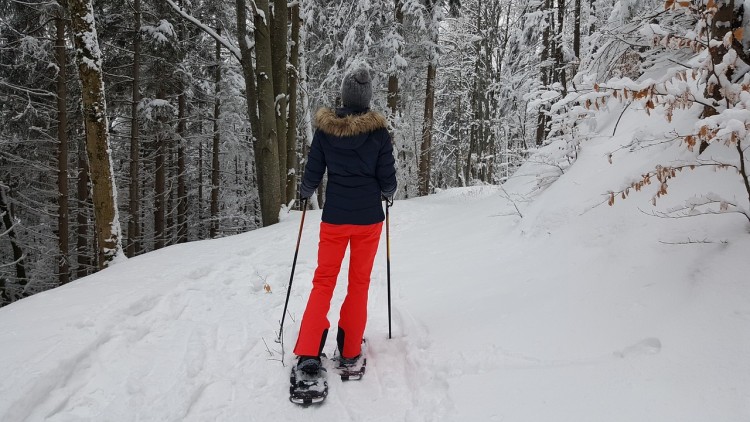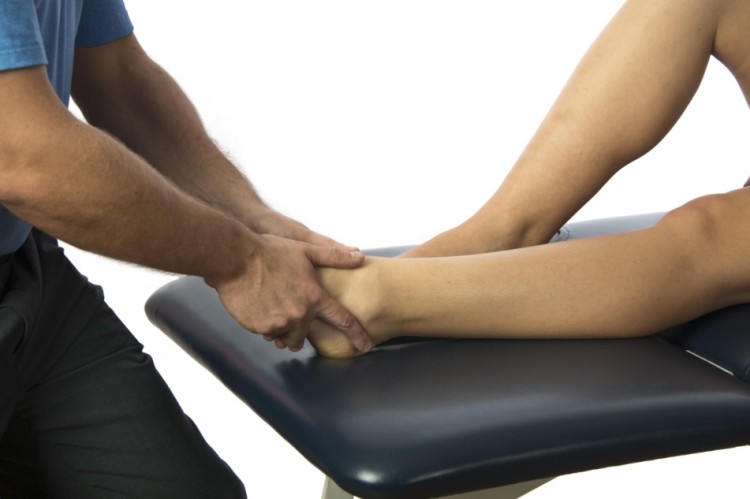Just because the weather is cold, it doesn’t mean that you have to stay cooped up inside the house until the temperatures rise. As an active person, there are plenty of outdoor activities that you can enjoy during the winter months, including the sport of snowshoeing.
There are many ways to snowshoe (including options close to home), so you don’t have to be an expert to get out and participate in the fun. However, no matter your skill level, everyone needs to be aware of the safety hazards of winter sports. Injuries and pain are very possible, including ankles that weren’t properly prepared for the adventure.
So, find out how to prevent ankle pain and injuries before you strap on those snowshoes and go snowshoeing.

Choose the proper boots and snowshoes for the right conditions to support your feet and prevent ankle pain and injuries while snowshoeing. Photo: Bureau of Land Management Alaska via Flickr
Some of the links in this article may contain affiliate links. When you purchase using these links, part of the proceeds go to Snowshoe Mag. Additionally, as Amazon Associates, we earn from qualifying purchases. Please see our disclosure for more details.
Choose the Proper Footwear
You are going to be out walking, or for some running, around in the snow for hours. To prevent ankle pain and injury when snowshoeing, you need boots that will support you through the ever-changing terrain and will keep your feet warm and dry.
In addition to your boot, matching your snowshoe with the type of snowshoeing that you are going to be doing is key. Consider which of these you plan on taking part in before purchasing a shoe:
- Casual walking
- Deep snow backpacking
- Steep Hills
- Running
When your feet are properly supported in the correct boot or snowshoe, you will be less likely to suffer injuries from falls or stumbles. Additionally, you will put the proper pressure in the right areas to avoid hurting yourself due to overexertion or improper posture.
Read More: 7 Beginner Snowshoes for Varied Terrain
Strengthen Your Ankles with Exercise
Are you someone that often rolls their ankles when taking part in normal physical activity? For example, you jump up to shoot a basket and come down with no support from your ankle at all. Or you’re walking down the street and hit an uneven bump in the road, and the first thing to give out is your ankle. It’s not because you’re clumsy, per se. Instead, it’s most likely because your ankles aren’t as strong as they could be.
The condition is actually called chronic ankle instability, and it usually happens after there have been several sprains or strains on the ankle already. It’s most common among athletes, but anyone can suffer from it. It’s often the result of failing to fully heal or rehabilitate that part of the body. It can be extremely frustrating and painful to deal with, and it can stop you in your tracks.
You don’t want to be out miles from the car in your snowshoes when your ankles decide they aren’t going to work anymore. Instead, you need to prepare by building up your ankle strength before you go.
First of all, you should go through proper physical therapy for rehab after an ankle sprain or injury (and avoid misconceptions about treating sprained ankles after it happens). Then when healed, keep working on building up the bones, muscles, and tendons in that area with ankle exercises.
For some, bracing is required, while a few people may need surgery. That’s something that should be discussed with your medical team if you are serious about snowshoeing without ankle discomfort in the future.
Read More: Improve Your Ankle and Wrist Mobility for Snowshoeing

Take it easy to start and choose areas close to you that are fairly flat and easy to navigate. Photo: Paul Wowk
Take It Easy To Start
You may think that there isn’t much to snowshoeing until you get out. For your first snowshoeing experience, try an area close to you and pick trails that are fairly flat and easy to navigate. This outing is where you can take the time to work on your technique.
Also, keep your first outing short and break for the day to allow your joints to adjust and prevent sprain or strain on any of those body parts. You can increase your time as you get more comfortable.
Read More: Top 10 Snowshoe Tips for First-Timers
Check Your Snowshoe Stance
The first thing you will notice when you strap on your snowshoes is that your stance might be different than what it is for other activities. Instead of standing fully upright, your body automatically will widen out a bit. That means you add pressure to your ankles, groin, and hips.
However, though you may be standing slightly wider than normal, the snowshoes should not cause you to drastically change your walk. If you’re walking differently when snowshoeing to the point it’s causing ankle pain, you may have the incorrect snowshoe size and too wide of snowshoes for your body and build.
Read More: Definitive Guide: How To Choose Snowshoes for Your Needs
Try Using Poles
In addition to keeping your regular stance, you can take some of the pressure off of your lower body by utilizing snowshoeing poles on your travels.
Poles give you a bit more balance and also offer a workout to your upper body. Using poles is a matter of preference, and you can use one pole or two. If you do decide to use poles, there are a few features to keep in mind for your choice.
Read More: What To Bring When Snowshoeing: Top Accessories for the Day Hiker

Try using poles to take some of the pressure off your lower body. Photo:Daniel Stuhlpfarrer via Pixabay
If You Fall
There may be something in your head saying, “Why would I want to know that? I’m not going to fall. I’m an experienced athlete.” Well, if you are experienced, then you know that accidents happen. Even the most advanced athletes make mistakes once in a while.
On snowshoes, there’s always a possibility of falling. When you feel you’re about to fall when snowshoeing, you want to be sure that you do it as safely as possible to prevent pain injury to your ankles, knees, back, and other body parts.
When the time comes when you feel as though you’re losing your balance (these balance exercises can help), lean back or to the side to prevent from tumbling forward. Most falls happen when you’re going downhill, and you want to stop that motion before you go flying all the way to the bottom.
Also, don’t put any added pressure on your body when you get up. Roll to your front if possible, put one knee up and use your poles to push yourself to a half-kneeling position. Then raise yourself back to standing.
Read More: Safety First: Snowshoeing Hazards and How To Avoid Them

If you have any concerns about your ankles, see a chiropractor before you go snowshoeing. Photo: iStock
See a Chiropractor Before You Go
Before you head out on your venture, you may want to seek the attention of a professional chiropractor in your area. They can take a look at your body as a whole, including your ankles, to make sure that you are up for the challenge ahead of you.
If there are any noted problems, you will get a treatment plan and recommendation for exercises and other things you can do at home to get yourself ready. You don’t want to take any chances with your body not being in peak performance when participating in the activity.
Which of the recommendations above have you tried to prevent ankle pain when snowshoeing? What other advice do you have to share? Please let us know in the comments below.
This article was first published on November 11, 2018, and was most recently updated on October 25, 2022.
Read Next: 5 Common Misconceptions About Treating Sprained Ankles






Leave a Comment